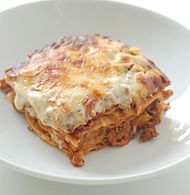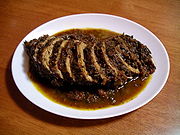- Meal structure in Italy
-
Italy has its own meal structure, which in essence is the typical European one, consisting of breakfast, lunch and dinner (there is also a mid-afternoon snack called merenda). Italians also divide a main celebration meal into several different courses.
Contents
Daytime meal structure
Breakfast (Colazione)
Breakfast is the first meal in Italy, and traditional Italian colazione is continental in style, unlike the full British and Irish breakfast. The traditional breakfast in Italy is simply Caffè e latte (hot coffee with milk) or coffee with bread or rolls, butter, and jam—known as prima colazione or just colazione. Fette biscottate (a cookie-like hard bread often eaten with butter and jam) and biscotti (cookies) are commonly eaten. Children drink hot chocolate, plain milk, or hot milk with very little coffee. If breakfast is eaten in a bar (coffee shop), it is composed of cappuccino e cornetti (its French and European equivalents are brioches, or croissant-like pastries) (frothed hot milk with coffee, and a pastry) or espresso and pastry. Other products such as breakfast cereals, fruit salad (Macedonia), muesli and yogurt are becoming increasingly common as part of the meal. It is very common for some Italians, mainly from the Central and Southern regions, to have a quick breakfast snack during the morning (typically a panino, or bread roll). Even though this is the traditional Italian breakfast, it also varies by region. People may eat porridge in Northern Italy, and some of the colder regions such as the Aosta Valley or Trentino-Alto Adige/Südtirol. As a matter of fact, in some regions such as Tuscany and Umbria, in the past, some children and adults alike used to drink red wine (notably Chianti) in which they dip their biscuits. Today, and with the abundance of British tourists coming to Italy, the full breakfast is becoming more popular and can be found in several hotels. There are also ancient establishments, such as the Babington's tea room in Rome, which still cater to tourists and locals which offer the Full British breakfast, including sausages, bacon, eggs, black pudding, mushrooms etc. (American breakfast dishes, such as pancakes with maple syrup, are served there, too). In Italy, people usually have breakfast between 07.00 and 10.00.
Lunch (Pranzo)
 Lasagna, a type of meal which one might have for lunch or pranzo in Italy.
Lasagna, a type of meal which one might have for lunch or pranzo in Italy. An Insalata Caprese, a cold dish which might be consumed at a lunch in Italy during the hot summer.
An Insalata Caprese, a cold dish which might be consumed at a lunch in Italy during the hot summer.
Lunch is traditionally regarded as being the most important meal. Most shops close down in the pausa pranzo (lunch break) between 13.00 and 16.00; until recent times, most people, even workers, came home to have a meal with their family, often inviting friends and relatives to come along. Abroad, Italians are often stereotyped of having long meals, however this is not always the case, and as the country has become more modernized, there is often less time for long meals. Despite this, most Italian families still get together for a big family meal on Sundays, special occasions and Saints' and Holy days. In most schools, children are given a lunch break where they can choose to go home and have lunch, or stay at the school canteen/cafeteria or eat a packed lunch. The introduction of fast-foods, takeaways and frozen/tinned foods has meant that Italians tend to eat less home-made food, yet fresh food is still quite common, and in many places people buy bread, milk and ingredients daily. Many adults still make their own food (i.e. tomato sauce from their own tomatoes), and takeaways are still not very frequent, notably in the more rural areas or Southern regions. Italians at lunch-time usually, even in normal days, have a layout: a first course, a second course and usually dessert or fruit.
With the introduction of fast-food restaurant chains, many workers or commuters tend to eat less at home and quickly have a meal at some restaurant like McDonald's or Burger King. Italy has got several foreign fast-food chains, and they are frequently found in big cities (Milan, Rome, Turin and Naples) or along motorways. However, to conserve the tradition of Italian food, Italy has several Italian fast-foods such as Autogrill, which makes panini, little pizzas or more traditional Italian meals. Pizzerias are still very popular with people and many have lunch in them. In recent years, dürüm, which Italians refer to as kebab, has become widely popular with younger people.
Mid-afternoon snack (Merenda)
In Italy, many children and adults alike have a mid-afternoon snack called merenda at around 15.00 to 16.30/17.00. It is usually had after school or in the middle of the afternoon, and can be anything. Traditionally, merendas where usually similar to breakfasts, and might have been a hot milky drink with bread and honey/jam or cornetti/brioches, but today other foods are eaten, such as yogurt, ice cream, granita, fruit salad, nuts, pistachios, biscuits and cookies, cake, sweets, etc. Especially in centre Italy very commons merenda for the children are pane e olio (roasted bread with garlic, salt and oil) and pane e pomodoro (roasted bread rubbed with fresh tomatoes).
Dinner (Cena)
Dinner is usually and traditionally a light meal in Italy. When Italians dine out, they usually do so for dinner, or cena, rather than lunch, and pizzerias and restaurants are popular choices. For cena, people usually have lighter food, such as soup, broth, salad, cold meats, pasta, or the leftovers of lunchtime.
Traditional structure of Italian meal
A structure of a traditional Italian meal in its full form.[1]
Aperitivo
 A glass of sparkling Prosecco as an appetiser.
A glass of sparkling Prosecco as an appetiser.
The aperitivo opens a meal, and it is virtually the same to an appetiser or drinks given at the beginning of a meal. Most people gather around standing up and have alcoholic/non-alcoholic drinks such as wine, prosecco, champagne or sparkling drinks. Sometimes small chunks of food are consumed, such as olives, crisps, nuts, cheese, sauce dips, little quiches etc.
Antipasto
The antipasto is the slightly heavier starter course. It is usually cold (not in all cases) and lighter than the first course. Cold meats and hams (salami, mortadella, Parma ham etc.), cheeses (mozzarella, scamorza), sandwich-like foods (panini, bruschette), cold salmon or shrimps with sauces are usually eaten, but also more elaborated cold or hot dishes.
Primo
The primo is the first course. It is hot food and heavier than the antipasto, but lighter than the second course. It usually consists of non-meat or fish like foods. Examples of things which would be eaten at a primo could be risotto, pasta, soup and broth, gnocchi, polenta, crepes, casseroles, lasagnas.
Secondo
The secondo is the heartiest and main course of an Italian meal, sometimes called the piatto principale or the main course/meal. Foods consumed in this course include different meats and types of fish, including turkey, sausage, pork, steak, stew, beef, zampone, cod (baccala), salmon, lobster, lamb, chicken, or a roast.
Contorno
With the secondo is served the contorno, which are the side plates. This usually consists in raw or cooked, hot or cold, vegetables.
Dolce
After the secondo there is the dolce, or dessert. It is popular, and meals eaten here depend by region and occasion. Common ones include tiramisu , zuppa inglese, panna cotta, cake or pie, Panettone or Pandoro (these last two are only served on Christmast time). Ice-cream can be eaten too.
Frutta con frutta secca/formaggio
After the dolce, there is fruit or frutta, which is eaten often with nuts or cheese to accompany it. There is no established set of fruits, though local traditions may dictate otherwise.
Digestivo
The digestivo, also called ammazzacaffè if served after the coffee, is the drink to conclude the meal. Drinks such as Grappa, Amaro, Limoncello or other fruit/herbal drinks are drunk. Digestivo indicates that the drinks served at this time are meant to ease digestion after a long meal.
Caffè
Coffee is often drunk at the end of a meal, even after the digestivo. Italians, unlike many countries, do not have milky coffees or drinks after meals (such as Cappucino or Caffe macchiato), but strong coffee-drinks such as espresso, which is often drunk very quickly in small cups at very high temperatures.
References
Categories:
Wikimedia Foundation. 2010.









